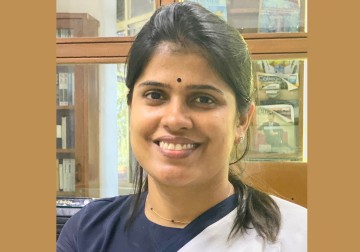Dry eye disease is an ocular condition caused by tear film instability or by an inadequate production of tears. The treatment depends on the severity, and ranges from eye drops for lubrication, steroids, and even surgery. Dr Swati Singh is an Ophthalmologist at L V Prasad Eye Institute, and her area of expertise is dry eye disease (DED). She manages and treats patients with DED and other ocular surface diseases like Stevens-Johnson syndrome. Her areas of interest include improving tear production in patients with DED.
Here, Dr Singh talks about her latest review paper on biomaterials for treating dry eyes and what got her started on DED research.
How do we treat DED today?
DED is a very common eye health problem. The current treatment is palliative, which means that there is no cure and clinicians can only address the symptoms of the disease like dryness and inflammation. Patients with dry eyes get lubricants like eye drops, which provide symptomatic relief. They often need prescription drugs alongside lubricants every few hours, several times in a day, and throughout their lifetime.
What got you interested in dry eye disease research?
Years ago, I was practicing in Ambala, a small town in Haryana on the border with Punjab. My consulting room had a big window with sunlight streaming in. Coming in, you would face me with the window right behind me. One day, a young woman with dry eye disease came in for a consultation. The bright sunlight in my room had made her squint and squirm uncomfortably in her chair. Her condition was severe, and she needed surgery. But even after the surgery, her problems did not resolve, and she could not produce tears. In one of the many follow-up visits, she asked me when she would be ‘normal’ again. It threw me off. I felt frustrated by my inability to answer her question. I had come to face the limits of my understanding of the condition. What was wrong with my patients' glands? Was there no way to help her? I wanted to find the answers. And so began my interest in DED research.
In this review you discuss biomaterials as a drug delivery system for dry eye disease. Why biomaterials?
Most of the current treatment for dry eyes has many shortcomings, like limited bioavailability and the need for frequent drug re-use. Biomaterials have the potential to hydrate the eye and increase bioavailability of drugs in the eye, thereby reducing the need for frequent eye-drops. I am keen to explore biomaterials’ ability as a drug-delivery system to ease the problems associated with dry eye disease. That is where Minal came on board as a collaborator. Dr Minal Thacker has expertise in nanomedicine and a PhD in biomedical engineering with research experience on drug-eluting contact lenses. The review paper was a result of our aligned interests and subject expertise.
What do you think is the future of biomaterials?
In the review paper we discuss several studies with different biomaterials, but biomaterials have a long way to go. There are very few long-term animal studies (none are longer than a month), and there isn’t enough safety data. Only when there is enough compelling evidence can we move on to human trials. If biomaterials pass this stage too, they go for regulatory approval and commercial use of biomaterials for dry eye disease treatment. I think biomaterials are promising. They can deliver treatment drugs more effectively into the eyes of patients with Dry Eye Disease. The answer lies in more research, from discovery to translation.
Dr Swati Singh spoke to Yamini Joshi, Science Writer, LVPEI.



